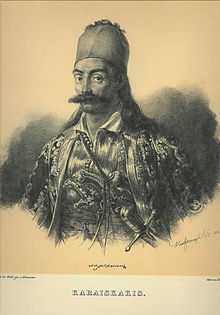Georgios Karaiskakis
| Georgios Karaiskakis Γεώργιος Καραϊσκάκης | |
|---|---|
 Georgios Karaiskakis; lithography by Karl Krazeisen. | |
| Nickname(s) | The Nun’s Son |
| Born |
January 23, 1780 Mavrommati, Karditsa or Skoulikaria, Arta |
| Died |
April 23, 1827 (aged 47) Faliro, Piraeus |
| Allegiance |
|
| Years of service | 1796 - 1827 |
| Rank | General |
| Commands held | Commander of the Army in Central Greece |
| Battles/wars | Greek War of Independence |
Georgios Karaiskakis (Greek: Γεώργιος Καραϊσκάκης) born Georgios Iskos (Greek: Γεώργιος Ίσκος) (January 23, 1780 or January 23, 1782 – April 23, 1827) was a famous Greek klepht, armatolos, military commander, and a hero of the Greek War of Independence.
Early life
Karaiskakis was born either in a monastery near the village of Mavrommati (Greek: Μαυρομμάτι), in the Agrafa mountains (located in what is now the Karditsa regional unit, Thessaly) or in a monastery near the village of Skoulikaria (Greek: Σκουληκαριά) close to Arta. His father was the armatolos of the Valtos district, Dimitris Iskos or Karaiskos, his mother Zoe Dimiski, a nun from Arta and cousin of Gogos Bakolas, captain of the armatoliki of Radovitsi. He was of Sarakatsani[1] descent. He was known also as “The Nun’s Son”.
At a very early age he became a klepht in the service of Katsantonis, a famous local Agrafiote brigand captain. He excelled as a klepht - agile, cunning, brave and reckless - and rose quickly through the ranks, eventually becoming a protopalikaro, or lieutenant.
At the age of fifteen he was captured by the troops of Ali Pasha and imprisoned at Ioannina. Ali Pasha, impressed by Karaiskakis’s courage and intelligence, and sensing his worth as a fighter, released him from prison and put him in the care of his personal bodyguards. He served as a bodyguard to Ali Pasha for a few years before losing favour with the Ottoman warlord and fleeing into the mountains to continue life as a klepht.
Greek War of Independence

During the early stages of the war, Karaiskakis served in the militia in the Morea (Peloponnese), where he participated in the intrigues that divided the Greek leadership. Nonetheless, he recognized the necessity of providing Greece with a stable government and was a supporter of Ioannis Kapodistrias who would later become Greece's first head of state.
Karaiskakis's reputation grew during the middle and latter stages of the war. He helped to lift the first siege of Missolonghi in 1823, and did his best to save the town from its second siege in 1826.
That same year, he was appointed commander-in-chief of the Greek patriotic forces in Rumeli, achieving a mixed response: while failing to cooperate effectively with other leaders of the independence movement or with the foreign sympathizers fighting alongside the Greeks, he gained some military successes against the Ottomans.
His most famous victory was at Arachova, where his army together with other revolutionary leaders, crushed a force of Turkish and Albanian troops under Mustafa Bey and Kehagia Bey. Victories such as the one at Arachova were especially welcome amid the disasters that were occurring elsewhere.
In 1827, Karaiskakis participated in the failed attempt to raise the siege of Athens, and attempted to prevent the massacre of the Turkish garrison stationed in the convent of Saint Spyridon in Piraeus.
He was killed in action on his Greek name day, 23 April 1827, after being fatally wounded by a rifle bullet in battle. According to Karaiskakis's expressed desire to be buried on the island of Salamis when he died, he was buried at the church of Saint Dimitrios on Salamis.
Honours and popular culture

King Otto of Greece posthumously conferred Karaiskakis the Grand Cross of the Order of the Redeemer.[2]
Karaiskaki Stadium in Neo Faliro, Piraeus is named after him as he was mortally wounded in the area.
Dionysis Savvopoulos has written both music and lyrics to the popular Greek song Ode to Georgios Karaiskakis (Greek: Ωδή στο Γεώργιο Καραϊσκάκη).
Family
Karaiskakis was married to Engolpia Skylodimou, and had three children: daughters Pinelopi and Eleni, and the only son Spyridon.
See also
References
| Wikimedia Commons has media related to Georgios Karaiskakis. |
- ↑ Clogg, Richard (2002). Minorities in Greece: aspects of a plural society. London: Hurst. “...klepth heroes of the revolutionary period such as Katsandonis and Karaiskakis were Sarakatsani, and the Sarakatsani themselves believed they were Greek patriots whose sense of freedom could suffer no restrains...”
- ↑ A.I. Kladis (1837). "Κεφάλαιον Ὄγδοον. Περὶ τῆς συστάσεως Τάγματος Ἀριστείας διὰ τὸ Βασίλειον τῆς Ἑλλάδος." [Chapter Eight. On the establishment of an Order of Excellence for the Kingdom of Greece]. ΕΦΕΤΗΡΙΣ (Almanach) τοῦ Βασιλείου τῆς Ἑλλάδος διὰ τὸ ἔτος 1837. Athens: Βασιλικὴ Τυπογραφία καὶ Λιθογραφία. pp. 123–136.
-
 This article incorporates text from a publication now in the public domain: Chisholm, Hugh, ed. (1911). Encyclopædia Britannica (11th ed.). Cambridge University Press.
This article incorporates text from a publication now in the public domain: Chisholm, Hugh, ed. (1911). Encyclopædia Britannica (11th ed.). Cambridge University Press. - Greek Wikipedia Entry
|